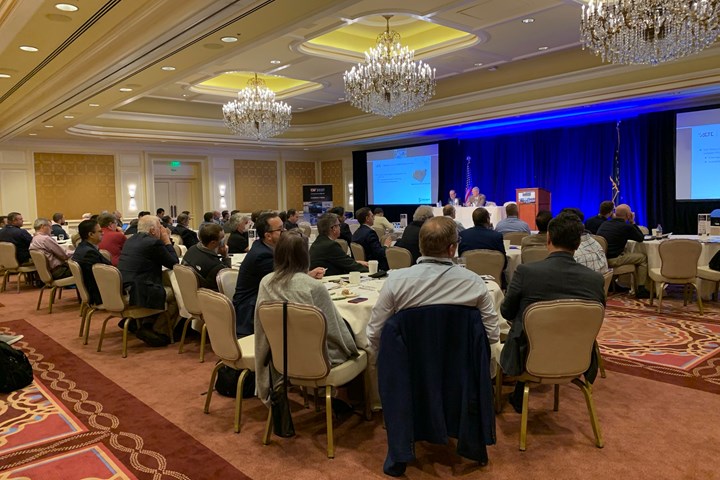The future of carbon fiber manufacture
Later this month, CW’s 25th anniversary Carbon Fiber Conference promises to be among the most important as dynamic market forces are putting unusual pressure on the carbon fiber supply chain.
CompositesWorld is hosting the 25th annual Carbon Fiber Conference this month from Nov. 15-17, 2022 in Greenville, S.C., U.S. The conference is, as the name implies, highly focused on the exploration of carbon fiber composites manufacturing. This business/technical event includes an examination of the entire carbon fiber value chain, from supply of carbon fibers to processing of intermediates to fabrication of finished parts.
Every Carbon Fiber Conference features a pre-conference seminar, during which we provide an in-depth, market-by-market analysis and forecast of the global supply and demand of carbon fibers. This year, as has been the case for the last several, this forecast is being presented by Tony Roberts and Dan Pichler, both of whom are industry veterans and possess extensive carbon fiber expertise.
This supply and demand outlook is always interesting as it provides the industry’s most comprehensive overview of where carbon fiber is most needed and how carbon fiber manufacturers are responding. There are, of course, several variables involved here. Different end markets and applications demand carbon fibers with very specific properties. For example, carbon fibers targeted toward the wind energy market are very different from the carbon fibers targeted toward the commercial aerospace or defense markets.
Part of what we’ll be doing at the Carbon Fiber Conference is helping the supply chain sort through these market signals and determine where and how growth will come.
There is also the issue of geography. Because carbon fiber export is often restricted or tightly controlled, where it’s manufactured is important — and, by extension, where it’s not manufactured.
Tony and Dan do a great job putting these variables in context as part of their presentation. This year, however, they will have their hands particularly full: The carbon fiber supply chain is, arguably, at the most pivotal point in its history. There are several reasons for this:
Commercial air travel recovery. Through much of 2020 and into 2021, COVID-19 caused a large drop in carbon fiber demand as commercial air travel suffered a massive slowdown. As the pandemic winds down and as commercial air travel begins its recovery, demand for carbon fiber in aerostructures is surging.
Longer wind turbine blades. In 2010, the average wind turbine rotor diameter was 115 meters, and at this size, there was not great need for the lighweighting and strength properties of carbon fiber. However, in 2021, the average rotor diameter was 128 meters (and rising). These longer blades have driven demand for carbon fiber in pultruded spar caps, which are used in almost every blade made today. This has made the wind energy industry by far the largest consumer of carbon fiber in the world. As wind turbines are refitted with longer blades, and as offshore wind expands, carbon fiber demand in this sector will only increase.
Emerging markets. There are two markets that, if they come to fruition as hoped, could put unprecedented pressure on the carbon fiber supply chain. One of these markets is filament-wound pressure vessels for hydrogen storage. The other is the advanced air mobility (AAM) market. Each is nascent, dynamic and fast-growing, but also surrounded by uncertainty about the pace and timing of their maturation. This makes the forecast of their future demand for carbon fiber, right now, unusually difficult to calculate.
The bottom line is that there is a global carbon fiber shortage. And, if these markets evolve as their advocates expect, demand will not only increase, but increase substantially.
Given this, it makes sense that carbon fiber manufacturers expand capacity, right? Yes and no. Carbon fiber manufacturers face unusual challenges that prevent them from easily and quickly expanding capacity to meet demand.
First, a new carbon fiber line costs at least $50 million and requires a dependable supply of polyacrylonitrile (PAN) precursor, which is also expensive and difficult to source. Second, a new carbon fiber line takes about two years to construct and commission. Third, not all carbon fiber is alike, thus a given carbon fiber line is designed to produce a specific carbon fiber with specific properties, which makes it suitable for specific applications. Such a targeted capital outlay means that a carbon fiber manufacturer needs strong signals and strong commitments from its customers to justify capacity expansion.
Part of what we’ll be doing at the Carbon Fiber Conference is helping the supply chain sort through these market signals and determine where and how growth will come. I hope you will join us in Greenville to be a part of this effort. Visit www.carbonfiberevent.com to learn more.
Related Content
Your must-have composites industry guide for 2025
Welcome to CW’s annual SourceBook, your guide to suppliers of machinery, materials, software and other services for the composites industry.
Read MoreAs 2023 begins, a look back at trending CW topics in 2022
With 2022 now behind us, CW’s editor-in-chief Jeff Sloan takes a look at the CW stories last year that received the most reader attention.
Read MoreCelebrating National Composites Week
August 21-25, 2023 is National Composites Week. This year’s theme is “Composites Are Now,” recognizing the ways composites are shaping the world today.
Read MoreA return to JEC World
CW editor-in-chief Scott Francis reflects on the ways in which the composites industry has changed and also stayed the same based on observations from this year’s JEC World.
Read MoreRead Next
VIDEO: High-volume processing for fiberglass components
Cannon Ergos, a company specializing in high-ton presses and equipment for composites fabrication and plastics processing, displayed automotive and industrial components at CAMX 2024.
Read More“Structured air” TPS safeguards composite structures
Powered by an 85% air/15% pure polyimide aerogel, Blueshift’s novel material system protects structures during transient thermal events from -200°C to beyond 2400°C for rockets, battery boxes and more.
Read MorePlant tour: Daher Shap’in TechCenter and composites production plant, Saint-Aignan-de-Grandlieu, France
Co-located R&D and production advance OOA thermosets, thermoplastics, welding, recycling and digital technologies for faster processing and certification of lighter, more sustainable composites.
Read More














.jpg;maxWidth=300;quality=90)








